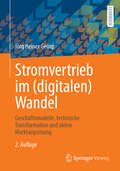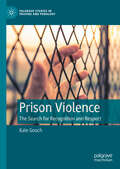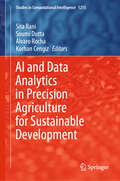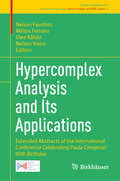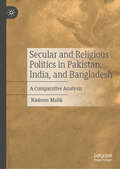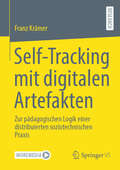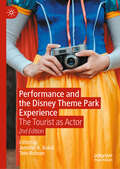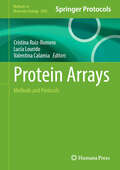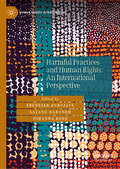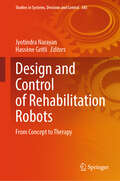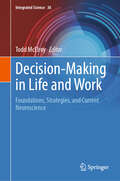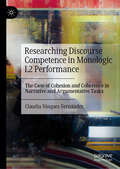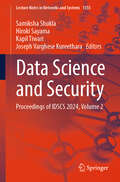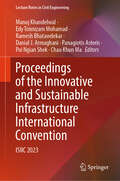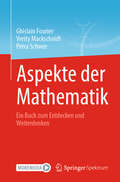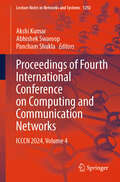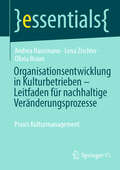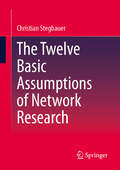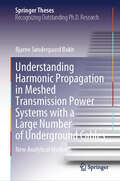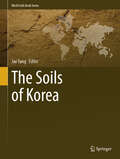- Table View
- List View
Stromvertrieb im (digitalen) Wandel: Geschäftsmodelle, technische Transformation und aktive Marktanpassung
by Jörg Heiner GeorgIn diesem Lehrbuch wird ein grundlegendes Verständnis für Geschäftsmodelle speziell im Stromvertrieb vermittelt und wesentliche Funktionen des Betriebsmodells (Aufbau- und Ablauforganisation) erklärt. Dabei hat der Autor auf Praxisbezug Wert gelegt und sowohl die Treiber der Digitalisierung als auch die Wirkungsmechanismen der Transformation sowie datengetriebene Geschäftsmodelle beschrieben. Architektur und systematischer Aufbau möglicher Geschäftsmodelle sind anhand von Teilmodellen nachvollziehbar dargestellt und veranschaulicht. Das Buch hilft Studierenden energietechnischer, energiewirtschaftlicher und angrenzender Fachbereiche aktuelle Modelle zu verstehen, zu analysieren und schafft damit die Grundvoraussetzung diese Kenntnisse im späteren Berufsleben einzusetzen. Die vorliegende Neuauflage trägt mit einem eigenen Kapitel der rasanten Entwicklung der Elektromobilität Rechnung und zeigt verschiedene Geschäftsmodellansätze im Bereich des Ladestromvertriebs auf. Zudem wird die zunehmende digitale Vernetzung von dezentralen Stromerzeugungsanlagen und flexiblen Verbrauchsgeräten unter Einbindung von KI und dynamischen Tarifen thematisiert.
Prison Violence: The Search for Recognition and Respect (Palgrave Studies in Prisons and Penology)
by Kate GoochThis book analyses the nature, causes, logic, and culture of prison victimisation in an English young offender institution for young men aged 18-21 years old. Drawing on ethnographic and qualitative research, this book offers a comprehensive analysis of the gendered, situational, individual, and moral components of prison victimisation. It explores how wider technological, economic, policy, political, and cultural changes have altered the texture and structure of prison life and prison violence, and with what consequences. Ultimately, the book argues that high levels of prison violence are not inevitable. Rather, the prevention of prison violence requires a just, lawful, humane, and hopeful environment, and failing to create such is tragically life-changing for young prisoners.
Artificial Intelligence for Integrated Smart Energy Systems in Electric Vehicles (Lecture Notes in Electrical Engineering #1427)
by Surender Reddy SalkutiThis book provides a comprehensive exploration of cutting-edge research in electric vehicles (EVs) integrated smart energy systems with a main focus on the application of artificial intelligence (AI). This book offers a wide and comprehensive practical approach with the applications of AI to address the challenges and opportunities of modern hybrid energy systems for developing advanced hybrid intelligent methodologies for forecasting and scheduling variable power output from renewable energy sources (RESs) and EVs. This will enhance system flexibility and facilitate the integration of RESs and EVs efficiently, which is a step towards a sustainable future. The chapters cover diverse topics offering valuable knowledge and methodologies including an introduction to Artificial Intelligence (AI), Machine Learning (ML), Internet of Things (IoT), Cybersecurity, and their applications in modern power and energy systems, intelligent control of power electronics for RESs and EVs, intelligent charging management of EVs, etc. This book aims to provide insights into various suitable solutions to increase the security, reliability, and interoperability of the grid under high penetration of renewable energy, storage systems, and electric transport in the context of the modern smart grid. The multi-objective optimization problems such as economic and emission dispatch problems; flexibility and reliability problems; and economic and reliability problems are solved to determine the trade-off solutions using efficient evolutionary algorithms. The chapters cover diverse topics offering valuable knowledge and methodologies including an introduction to Artificial Intelligence (AI), Machine Learning (ML), IoT, Cybersecurity, and their applications in modern power and energy systems, intelligent control of power electronics for RESs and EVs, intelligent charging management of EVs, etc.
AI and Data Analytics in Precision Agriculture for Sustainable Development (Studies in Computational Intelligence #1215)
by Álvaro Rocha Soumi Dutta Korhan Cengiz Sita RaniThis book offers a comprehensive analysis of artificial intelligence (AI) and data analytics in precision agriculture. The integration of technology in agriculture is revolutionizing traditional farming practices, paving the way for sustainability. Precision farming, powered by AI, IoT, and big data, optimizes resource use by enabling real-time monitoring of soil health, weather conditions, and crop growth. Automated irrigation systems and drones reduce water wastage and enhance productivity. Biotechnology advances, such as genetically modified crops and CRISPR gene editing, improve yield, pest resistance, and climate adaptability. Vertical farming and hydroponics offer space-efficient solutions, minimizing land degradation and water consumption. Robotics and autonomous machinery streamline labor-intensive tasks, reducing reliance on chemical inputs. Blockchain ensures transparency in the food supply chain, promoting fair trade and reducing food fraud. Renewable energy sources, like solar-powered farms, further lower agriculture&’s carbon footprint. By adopting these innovations, farmers can produce more with fewer resources, ensuring food security while preserving the environment. Embracing technology-driven agriculture is crucial for meeting global food demands sustainably, combating climate change, and fostering economic resilience in farming communities. The future of agriculture lies in intelligent, data-driven, and eco-friendly solutions that balance productivity with environmental stewardship.
Spermatogenesis: Methods and Protocols (Methods in Molecular Biology #2954)
by Prabhakara P. ReddiThis volume presents a comprehensive collection of research methods at the cellular, molecular, and biochemical level to understand sperm production and function. Exploring spermatogenesis and testis biology, the book delves into epigenomics and transcriptomics, spermatogenic cell separation, identification of cell types and stages, and more. Written for the highly successful Methods in Molecular Biology series, chapters include introductions to their respective topics, lists of the necessary materials and reagents, step-by-step and readily reproducible laboratory protocols, and tips on troubleshooting and avoiding known pitfalls. Authoritative and practical, Spermatogenesis: Methods and Protocols serves as an excellent reference for basic applied researchers in the field of spermatogenesis and male fertility working with laboratory models as well as domestic animals.
Hypercomplex Analysis and Its Applications: Extended Abstracts of the International Conference Celebrating Paula Cerejeiras’ 60th Birthday (Trends in Mathematics #9)
by Uwe Kähler Nelson Faustino Milton Ferreira Nelson VieiraThis book contains a collection of short papers based on the presentations given at the international conference on Hypercomplex Analysis and its Applications celebrating Paula Cerejeiras&’ 60th birthday. These papers present the latest results as well as overviews on specific topics in the areas of hypercomplex and harmonic analysis as well as their connections with partial differential equations and spectral theory.
Secular and Religious Politics in Pakistan, India, and Bangladesh: A Comparative Analysis
by Nadeem MalikThis book thoroughly explores the complex relationship between secularism and religious politics in South Asia. It examines the historical and contemporary factors that have influenced the political landscapes of Pakistan, India, and Bangladesh, focusing on how colonial legacies, nation-building processes, and religious ideologies have shaped governance and social structures. Through comparative analysis, the book delves into the rise of Hindutva in India, the struggle between secularism and Islamism in Bangladesh, and the role of Islam in Pakistan's politics. By integrating diverse theoretical perspectives and historical contexts, this book offers a comprehensive understanding of the evolving nature of secularism and religious politics in these three nations. It also provides insights into the broader implications for democracy, pluralism, and religious freedom in South Asia. This book is essential reading for scholars, policymakers, and anyone interested in the intersection of religion and politics in one of the world's most complex and dynamic regions.
Self-Tracking mit digitalen Artefakten: Zur pädagogischen Logik einer distribuierten soziotechnischen Praxis
by Franz KrämerSelf-Tracking – etwa mit Schrittzählern, Fitness-Apps oder CO2-Trackern – steht exemplarisch für die Messregime in modernen Gesellschaften und ihren Anspruch, Verhalten zu steuern. Die pädagogischen Dimensionen dieser Praktiken sind bislang kaum systematisch erforscht. Die Studie füllt diese Lücke: Sie zeigt, wie Self-Tracking mit Lernen, Bildung, Üben und Erwachsenenerziehung verflochten ist. Empirisch fundiert rekonstruiert sie Praxen und Erfahrungen von Selbstvermesser*innen und stellt sie in Relation zu den Designs von Self-Tracking-Artefakten. Durch die Verbindung von Praxisforschung mit präzisen wie kreativen Medienanalysen eröffnet sie einen neuen Zugang zur Erforschung pädagogisierter Lebensführung – und tritt zugleich monokausalen Transformationsnarrativen der Digitalisierung kritisch entgegen. Das Buch richtet sich an Forschende, die sich mit digitaler Transformation und qualitativen Forschungszugängen zu Praktiken mit digital-materiellen Artefakten auseinandersetzen. Angesprochen sind auch Personen aus Bildungspraxis, Bildungspolitik und dem EdTech-Umfeld, die an Forschung zu den Widersprüchen und Brüchen digitaler Alltagspraktiken interessiert sind.
Performance and the Disney Theme Park Experience: The Tourist as Actor, 2nd Edition
by Jennifer A. Kokai Tom RobsonMost scholars and critics deny agency to the tourist in their engagement with the Disney theme park experience. The vast body of research and journalism on the Disney &“Imagineers&”—the designers and storytellers who construct the park experience—leads to the misconception that these exceptional artists puppeteer every aspect of the guest&’s experience. This anthology, now in its second edition, re-centers the park experience around its protagonist: the tourist, and addresses the Disney Parks using performance theory, an approach few to no scholars had used prior to the first edition. The authors of the individual essays, as well as the Introduction by Kokai and Robson, and an Afterword by world renowned tourism and performance expert Susan Bennett, recognize the inherently complicated nature of Disney. Many of the contributors consider themselves Disney fans, but also recognize the potentially problematic aspects of Disney parks. This collection permits both perspectives to exist side by side, informing rather than contradicting each other.
Protein Arrays: Methods and Protocols (Methods in Molecular Biology #2929)
by Cristina Ruiz-Romero Lucía Lourido Valentina CalamiaThis volume discusses the latest methods and applications of protein microarrays and helps researchers harness its power in their work. The chapters in this book explore protein microarray&’s development and fabrication, strategies for their data analysis, and wide-reaching applications in biology and disease research. Written in the highly successful Methods in Molecular Biology series format, chapters include introductions to their respective topics, lists of the necessary materials and reagents, step-by-step, readily reproducible laboratory protocols, and tips on troubleshooting and avoiding known pitfalls.Cutting-edge and thorough, Protein Arrays: Methods and Protocols is a valuable resource for graduate students, postdoctoral researchers, laboratory scientists, and industry professionals who wish to learn more about protein microarray technology.Chapter 3 is available open access under a Creative Commons Attribution 4.0 International License via link.springer.com.
Harmful Practices and Human Rights: An International Perspective (Human Rights Interventions)
by Ebenezer Durojaye Johanna Bond Satang NabanehHarmful Practices and Human Rights examines different forms of harmful practices, globally, which constitute human rights violations as guaranteed in international and regional human rights instruments. Drawing examples from Africa, Asia, North America, Europe, and Australasia, it demonstrates how these practices undermine the right to health, including sexual and reproductive health, and also impugn the dignity and autonomy of women and girls. Using diverse harmful practices as case studies, the book critically examines the factors that drive harmful practices in developing and developed countries. Specifically, this book focuses on a selection of harmful practices—including dowry payments, ukuthwala, intimate partner violence, harmful tobacco use and its gendered implications, trafficking in persons, widowhood practices, the chinamwari/khomba practice, and child marriage—from both the Global South and North. Its intent is to demonstrate the prevalence of these abuses and underscore the urgent need for states to take decisive steps toward eradication.
Clinical Applications of Spectral Photon Counting Computed Tomography Technology
by Krzysztof Kris Iniewski Salim Aymeric Si-MohamedDive into the transformative world of Spectral Photon-Counting Computed Tomography (SPCCT), the groundbreaking technology revolutionizing diagnostic imaging. This book explores the latest advancements in SPCCT systems, revealing their unparalleled precision in detecting chronic, acute, and emergency conditions. Discover the cutting-edge technique of color K-edge imaging, which, combined with innovative contrast agents, may unveil unprecedented diagnostic clarity. From technical breakthroughs to emerging clinical applications, this comprehensive guide charts the future of radiology. A must-read for researchers, clinicians, and imaging enthusiasts eager to harness the potential of SPCCT to redefine medical diagnostics and improve patient outcomes.
Design and Control of Rehabilitation Robots: From Concept to Therapy (Studies in Systems, Decision and Control #585)
by Jyotindra Narayan Hassène GritliThis book offers a comprehensive guide that explores the intricate world of rehabilitation robotics, bridging theoretical concepts with practical applications. It initiates with a meticulous examination of the historical evolution and present landscape of rehabilitation robotics, thereby establishing a foundational understanding of its trajectory and potential. Subsequent chapters navigate through pivotal areas such as human-robot interaction, sensing and perception technologies, path planning methodologies, telerehabilitation innovations, and inventive assist-as-need control schemes. Each subject undergoes careful scrutiny to underscore its significance and applicability in augmenting therapy outcomes and fostering patient autonomy. For instance, the discourse on human-robot interaction underscores the imperative need for designing robots that seamlessly integrate into rehabilitation settings while prioritizing patient safety and comfort. Similarly, the exploration of sensing and perception technologies illuminates the pivotal role these components play in enabling robots to interpret their environment and support healthcare professionals effectively. Moreover, the book delves into pertinent ethical and regulatory considerations inherent in the deployment of rehabilitation robots, accentuating the necessity for responsible and ethical practices in this burgeoning domain. Real-world case studies provide invaluable insights into the diverse applications of rehabilitation robots across various medical specialties, offering tangible examples of their impact on therapy outcomes, efficiency, and the challenges encountered in real-world implementation. By synthesizing pivotal insights and lessons gleaned throughout the discourse in the concluding chapter, the book underscores the transformative potential of rehabilitation robots in enhancing patient care and delineates strategies for further propelling the field forward. In essence, this book endeavors to furnish a comprehensive resource catering to researchers, engineers, clinicians, and policymakers alike, furnishing them with the requisite knowledge and tools to optimize patient-centric care in physical rehabilitation settings, and ultimately augmenting the quality of life for individuals grappling with physical impairments.
Decision-Making in Life and Work: Foundations, Strategies, and Current Neuroscience (Integrated Science #36)
by Todd McElroyThis groundbreaking volume brings together leading researchers to explore the latest findings on the psychological and physiological factors that shape decision-making. It offers a uniquely multidisciplinary perspective, integrating insights from neuroscience, economics, public policy, and other fields to provide a comprehensive understanding of how we make choices in both personal and professional contexts. Designed for researchers, professionals, instructors, and students interested in decision science, this book delves into several key areas. It explores the cognitive biases and heuristics that influence our decisions. The book also examines the role of emotions and intuition in decision-making. Additionally, it investigates the neuroscience behind information processing and judgment. It also provides strategies we can use to make better decisions in real-world settings. The chapters, written by experts in the field, cover a wide range of topics ranging from the foundations of decision theory to the latest research on the neural bases of decision-making, providing readers with a rich understanding of the subject. Through its multidisciplinary approach and emphasis on practical applications, this volume offers readers valuable insights and tools for enhancing their own decision-making skills. Whether you are a researcher studying decision-making processes, a professional looking to make better judgments in important situations, or an instructor teaching decision science, this book provides a comprehensive and accessible resource that will deepen your understanding of this critical area of human behavior.
Researching Discourse Competence in Monologic L2 Performance: The Case of Cohesion and Coherence in Narrative and Argumentative Tasks
by Claudia Vásquez FernándezThis book introduces you to an exploration of discourse competence as a core component of successful second language (L2) communication, highlighting its role to promote overall intelligibility levels in L2 learner performance. In doing so, this volume promotes the examination of L2 learner output from a discourse-oriented perspective through the articulation of discourse competence in terms of textual resources of cohesion and coherence, thus making the construct both instructable and researchable. Building on decades of L2 performance research, particularly within the Task-based Language Teaching (TBLT) approach, this book explores the potential of planning time as a pedagogical tool to promote discourse competence in second language (L2) learners and enhance overall levels of intelligibility in oral task-performance. Including guidelines for investigating L2 learner performance and lesson plans for the practical teaching of discourse resources in the L2 classrooms, this book promotes research of discoursal aspects of L2 learner task-performance and the implementation of an overall discourse-oriented perspective in the L2 classroom. This book constitutes a valuable resource for researchers, university students, instructors, and academics involved in the L2 teaching and learning field thus making it an essential reading for professionals in applied linguistics and language teaching associations worldwide.
Advances in Texture, Microtexture, and Allied Techniques: Measurements, Analyses, and Application (Materials Horizons: From Nature to Nanomaterials)
by David P. Field Satyam SuwasThis book presents the fundamentals of texture and microtexture with the latest developments in the field and relates the same for different materials and processes. Crystallographic phase and orientation define the anisotropy of crystalline materials. In polycrystalline materials, the preferred crystallographic orientation of grain distributions, also known as (crystallographic) texture, controls the properties of materials. The evaluation of texture has been traditionally carried out by X-ray diffraction and neutron diffraction. In recent times, microtexture-based techniques have been widely used not only to examine the crystallographic texture but also to investigate the micro-mechanisms controlling the development of texture and microstructure. It has, therefore, become almost mandatory to re-visit the physical phenomenon associated with materials from the viewpoint of microtexture. The individual chapters have been written by the renowned scientists working in the respective domain. The book can be a valuable reference for researchers and professionals interested in fundamentals of texture and microtexture and allied fields.
Data Science and Security: Proceedings of IDSCS 2024, Volume 2 (Lecture Notes in Networks and Systems #1355)
by Hiroki Sayama Samiksha Shukla Joseph Varghese Kureethara Kapil TiwariThis book presents best-selected papers presented at the International Conference on Data Science for Computational Security (IDSCS 2024), hosted by Christ (Deemed to be University), India, and technically sponsored by The Tejas Scientific Researcher Foundation, India, from 08–09 November, 2024. The book targets the current research works in the areas of data science, data security, data analytics, artificial intelligence, machine learning, computer vision, algorithms design, computer networking, data mining, big data, text mining, knowledge representation, soft computing, and cloud computing.
Proceedings of the Innovative and Sustainable Infrastructure International Convention: ISIIC 2023 (Lecture Notes in Civil Engineering #632)
by Edy Tonnizam Mohamad Manoj Khandelwal Ramesh Bhatawdekar Danial J. Armaghani Panagiotis Asteris Poi Ngian Shek Chau Khun MaThis book presents selected papers from the Proceedings of the International Conference on Innovative Infrastructures, ICII 2023, held in Kuala Lumpur, Malaysia, covering topic areas in mining geomechanics, ground control, engineering geology, geohazards, soft computing, and underground structures. The published articles cover the latest research studies in geotechnical and geoengineering with the focus of soft computing technology to solve complex geotechnical issues in mining, tunneling, and geotechnical structures. It also highlights state-of-the-art technologies adopted by the civil, geology, and mining industries which are not only commercially viable but also environmentally sustainable. The content of the papers appeals to researchers and industrial practitioners working in the field of geomechanics and geoengineering.
Aspekte der Mathematik: Ein Buch zum Entdecken und Weiterdenken
by Petra Schwer Ghislain Fourier Verity MackscheidtEntdecken Sie eine faszinierende Sammlung von Themen und Projekten aus zehn unterschiedlichen Bereichen der Mathematik: Von linearer Algebra über Geometrie und Topologie bis hin zu Graphentheorie und Kombinatorik – die Themen in diesem Buch sind vielfältig und bieten einen guten Einstieg in verschiedene Bereiche der modernen Mathematik. Elementare Vorkenntnisse in linearer Algebra und Analysis reichen völlig aus, um alle Inhalte des Buches zu verstehen. Dieses Buch bietet eine perfekte Grundlage für Proseminare, interaktive Lehrformate, Studierendenprojekte oder Abschlussarbeiten und eignet sich auch besonders für Lehramtsstudierende. Jedes der zehn Kapitel führt anhand konkreter Beispiele in die jeweils grundlegenden Konzepte und wichtigsten Fragestellungen ein. Sofern adäquat möglich werden historische Hintergründe beleuchtet und weiterführende Hinweise gegeben. Zahlreiche kurze Projektbeschreibungen regen am Ende jedes Kapitels dazu an, das Wissen zu vertiefen oder direkt anzuwenden – sei es in Seminarvorträgen, Hausarbeiten oder Gruppenprojekten. Einige Projekte werden durch ein interaktives Julia/Jupyter-Notebook ergänzt, das die Projekte um zusätzliche Visualisierungs- und Programmieraspekte erweitert. Konkrete Vorschläge für Querschnittsseminare ergänzen dieses Material. Tauchen Sie mit diesem vielseitigen und praxisorientierten Werk in die Welt der Mathematik ein!
Proceedings of Fourth International Conference on Computing and Communication Networks: ICCCN 2024, Volume 4 (Lecture Notes in Networks and Systems #1292)
by Akshi Kumar Abhishek Swaroop Pancham ShuklaThis book includes selected peer-reviewed papers presented at fourth International Conference on Computing and Communication Networks (ICCCN 2024), held at Manchester Metropolitan University, UK, during 17–18 October 2024. The book covers topics of network and computing technologies, artificial intelligence and machine learning, security and privacy, communication systems, cyber physical systems, data analytics, cyber security for industry 4.0, and smart and sustainable environmental systems.
Organisationsentwicklung in Kulturbetrieben – Leitfaden für nachhaltige Veränderungsprozesse: Praxis Kulturmanagement (essentials)
by Andrea Hausmann Olivia Braun Lena ZischlerDieses essential beschreibt kompakt und praxisnah, wie Organisationsentwicklungsprozesse in Kulturbetrieben erfolgreich gelingen können. Nach einer Einführung in die wichtigsten Modelle, Strategien und Ansätze skizzieren die Autorinnen den Ablauf der einzelnen Phasen – von der Zielformulierung, Planung und Analyse der Ist-Situation über die Maßnahmenentwicklung und -umsetzung bis hin zur Evaluation und Verstetigung der Veränderungen. Aufbauend darauf diskutieren sie typische Handlungsfelder und notwendige Rahmenbedingungen und zeigen auf, wie mit Widerständen und Scheitern konstruktiv umgegangen werden kann. Ein weiterer Schwerpunkt liegt auf den Akteuren der Organisationsentwicklung sowie deren jeweiligen Aufgaben und Rollen. Darüber hinaus werden praxiserprobte Tools vorgestellt, die sich für den Start, die Umsetzung und die Evaluation von Organisationsentwicklungsprozessen in Kulturbetrieben eignen.
Optical Fiber Sensors and AI: Exploring the Fusion (Progress in Optical Science and Photonics #34)
by Santosh Kumar Amit Rai Vanita Bhardwaj Kamal KishorThis book highlights the exciting developments in optical fiber sensors and how artificial intelligence (AI) is boosting their performance and applications. It starts with an easy-to-understand introduction to the basics of optical fiber sensors and their many uses. Then, it moves on to the latest technological advancements, showing how AI is making these sensors smarter and more efficient. The book contains chapters demonstrating how machine learning contributes to real-time data analysis and how deep learning enhances sensor systems. There is also a focus on designing better sensor networks with the help of AI. The book explains how combining AI with the Internet of Things (IoT) and optical fiber sensors can create smart infrastructure solutions. Real-world case studies illustrate how AI-enhanced fiber-optic sensors are benefiting fields like healthcare and environmental monitoring. The book wraps up with a look at future trends and challenges in the world of AI-powered optical fiber sensing. This book is perfect for researchers, engineers, and anyone interested in the powerful combination of AI and optical fiber technology. It provides valuable insights into how these technologies can work together to create innovative and practical solutions.
The Twelve Basic Assumptions of Network Research
by Christian StegbauerThe book provides an orientation in network research grounded in the dozen most important assumptions that characterize this field. It shows why relationship structures and strengths are important. The structure of relationships is crucial for behavioral patterns and cultural developments. The book introduces the concept of "cognitive social structure" to explain how our behavior depends on our knowledge of social networks.
Understanding Harmonic Propagation in Meshed Transmission Power Systems with a Large Number of Underground Cables: New Analytical Methods (Springer Theses)
by Bjarne Søndergaard BukhThis outstanding PhD thesis reports on new analytical methods developed to analyse harmonic propagation in large transmission systems. The focus is on understanding the physical relationships between harmonic propagation phenomena in the passive grid caused by grid expansions or changes to existing transmission lines. Principal component analysis and partial least squares regression have been used as tools to investigate statistical correlations between harmonic distortion levels at substations, and a harmonic propagation model based on standing wave phenomena and techniques known from radio and microwave theory has been developed. Knowledge of the propagation phenomena has also been used to develop a new method for determining appropriate locations for harmonic mitigating equipment in a grid. Finally, the methods have been validated through both simulation models and harmonic voltage measurements obtained from the Danish transmission grid. Overall, this thesis reports new insights into harmonic propagation in power systems as the use of underground cables increases and offers new tools for analysing such phenomena. No previous examples of data-driven analyses of measurement data from a power system in the form presented here could be found in existing literature, thus paving a way to new possibilities for this emerging field.
The Soils of Korea (World Soils Book Series)
by Jae YangThis book offers an in-depth exploration of Korean soils, emphasizing their unique characteristics, historical significance, and innovative management practices. Soil is the foundation of life on Earth, providing essential resources for food, clothing, and shelter. In Korea, soil management has been pivotal in shaping agriculture, economy, culture, and environmental sustainability. Over the decades, Korean agriculture has evolved significantly, transitioning from production-focused strategies in the mid-twentieth century to sustainable and eco-friendly practices in recent years. Korean soil scientists have been at the forefront of these advancements, pioneering innovations in soil classification, fertilization programs, and the application of technologies like artificial intelligence. These contributions have established Korea as a global leader in soil science, highlighted by its successful hosting of the 2014 World Congress of Soil Science. This comprehensive book examines Korea&’s soil types, primarily derived from igneous and metamorphic rocks, and their diverse applications in rice paddies, upland fields, and greenhouses. It also explores the cultural and ecological value of soil, including its role in shaping Korean traditions and its contribution to ecosystem services. This book is an essential resource for researchers, policymakers, and anyone interested in soil science and sustainability. This book provides valuable insights into the profound ways soil has shaped Korea&’s past, present, and future, offering a window into one of the world&’s most dynamic soil landscapes.
